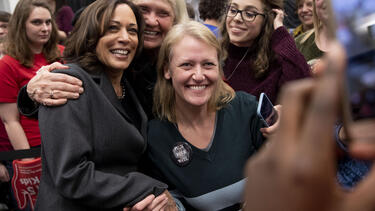What Kamala Harris’s Nomination Means for Women’s Equality
If Joe Biden is elected this November, Kamala Harris would be the first woman and the first person of color to serve as vice president. We asked Prof. Oriane Georgeac, who studies perceptions of diversity, if Harris’s nomination heralds an acceleration of progress for women generally.

Kamala Harris campaigning in Iowa in February 2019. Photo: Daniel Acker/Bloomberg via Getty Images.
What do we know about how people see women seeking high office or otherwise being ambitious?
People spontaneously associate leadership more with men than women, because stereotypes about men’s attributes (e.g., agency, rationality) overlap more than stereotypes about women’s (e.g., communality, emotionality) with the qualities that are expected of leaders in the West: aggressiveness, ambition, courage, etc. The first evidence of this “think leader, think male” form of gender bias was documented in the 1970s, and not much has changed since. A first challenge for women with leadership aspirations is therefore to overcome negative assumptions about their leadership potential, and to convince others that they possess the necessary qualities to fulfill a leadership role. In the process, ambitious women often face pressures to demonstrate purportedly masculine qualities and to de-emphasize so-called feminine ones. However, this is a double bind; women who come across as “masculine” often face backlash, because they violate people’s gendered expectations about how a woman should behave. Female leaders are therefore faced with a second challenge: looking the (masculine) “leader” part, without deviating too much from gendered expectations—a real conundrum, which can be all the more challenging for racial minority women as they also face racial bias.
You investigated the effect of the 2016 presidential election on attitudes toward women. What did you learn?
Gender attitudes are pretty stable and require much time to shift, but with my colleagues, Aneeta Rattan and Daniel Effron, I wondered whether a one-time event of historical significance could significantly change them. The 2016 U.S. presidential election, with its many debates around gender during the campaign, provided the perfect context to explore this. Across a variety of different measures, we asked two groups of U.S. adults about their attitudes toward women—one group in the days before the election, and the other in the days that followed.
“As inspiring as this nomination is, my research suggests that if people interpret it as evidence of women’s and minorities’ access to equal opportunity generally, they might become less sensitive to persisting inequalities in other domains.”
We found no evidence that the election changed the gender attitudes of Americans overall. Instead, what predicted a change was people’s preferred candidate. Post-election, we found that Trump supporters scored significantly higher on the Modern Sexism scale—a scale designed to capture more subtle and contemporary forms of gender bias, in the form of a denial of the existence of gender discrimination, opposition to women’s demands, and resentment toward women for perceived special favors. Trump supporters’ higher score on the Modern Sexism scale, in turn, predicted their reporting less concern about the gender pay gap, lower perceptions of discrimination against women but more against men, greater perceptions of progress towards gender equality, and greater perceptions of gender diversity at top levels in the United States.
In contrast, Clinton supporters’ attitudes towards women did not significantly differ pre- and post-election. These findings held after implementing several robustness checks, suggesting that historical events such as the 2016 U.S. presidential election can indeed affect people’s gender attitudes, though differently across political divides.
If Kamala Harris is elected vice president, is that milestone likely to spark progress on gender equality in other domains?
I have long been fascinated by the way in which we talk about social progress. Even just the term “progress toward gender equality” suggests that progress is a single, continuous path. My research highlights that this vision is mistaken. There are many different domains of inequality, and progress in some domains often coexists with lack of progress in others. For example, we have seen progress in the number of women sitting in Fortune 500 boardrooms over the past decades (going up from a few token women in 1995 to about 20% of board seats in 2015), but concomitantly, the gender pay gap has remained fairly unchanged (decreasing by less than .01 dollar per year during the same period).
It turns out that people often overlook the distinction between domains of inequality, and mistakenly interpret progress in one specific domain (such as top leadership representation) as “progress overall.” In a set of studies that I conducted with Aneeta Rattan, I indeed found that when people see more women being represented at top leadership levels, they overgeneralize this progress, and interpret it as evidence that women now have access to equal opportunities generally. In turn, this overgeneralization leads people to report less concern about persisting gender inequalities in other domains, such as the gender pay gap or the unequal distribution of housework across genders. This is of course a worrisome finding, given that concern with inequality predicts willingness to address it.
Turning to Kamala Harris’s nomination, it is undoubtable that a biracial Black-Indian woman being nominated by a major party for the vice presidency is a marker of major gender and racial progress in U.S. society. As inspiring as this historical nomination is, however, my research suggests that to the extent that people interpret it as evidence of women’s—and by extension, of minorities’—access to equal opportunity generally, they might become less sensitive to the persisting inequalities that women and minorities still face in other domains, such as the race and gender pay gaps, healthcare disparities, etc. Interpreting Harris’s nomination as evidence of the United States’ commitment to, rather than achievement of, social equality may be more conducive to addressing these persisting inequalities. Actually addressing them requires us to clearly define our goals and action plans for tackling ongoing inequality across multiple domains, in addition to celebrating the advancement that Harris’s nomination represents for women’s and minorities’ top leadership representation.